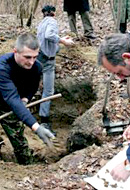Toward an Archeology of Hell

Remembrance is a contradictory imperative. Respectful preservation of the past, especially the remains of those who have gone before us, stands at odds with the need to understand the same past, especially through means like archeology. Preservation entails slowing the course of nature by repairing and even improving remains of the past, but archeology is controlled destruction in the name of enlightenment. When is such destruction permissible or even necessary?
In the study of the Holocaust, in particular, there are efforts to preserve key sites such as Auschwitz against the inevitability of disintegration and to commemorate through construction of new signs and symbols above Holocaust landscapes. But what are the proper morals and limits of the rapidly developing field of Holocaust archeology?
Consider the Nazis' four single-purpose death camps, Belzec, Sobibor, Chelmno, and Treblinka. Each has its own diabolical history. At Treblinka, 120 kilometers northeast of Warsaw, gas chambers and cremation pits consumed at least 800,000 Jews in 1942 and 1943. During an uprising in August, 1943 the Sonderkommado, Jews condemned to stack and burn the bodies of their people, rebelled. Parts of the camp were burned and several hundred prisoners escaped. After that, the camp ceased operation. Buildings were razed, graves dug up, human remains burned, bones ground, and everything planted over with trees and flowers.
Thus, a triple erasure occurred: Nazis slaughtered Jews, murderers obliterated their handiwork, and nature was permitted to take its course. The moment the Nazis abandoned Treblinka and the other sites, a fourth erasure began. In a "gold rush," the Soviet army and then the locals mined the camps for gold, silver, jewelry, dentures, and other belongings of the damned. This unholy recycling of wealth continues sporadically even today.
Now a monument stands at the approximate center of Treblinka's open fields and forests. But did any of it really happen? Where are the buildings, gas chambers, mass graves? Forgetting and denying are instincts as strong as remembrance, and the lack of physical remains has made Treblinka a target for yet another round of erasure—by Holocaust deniers. Perhaps it was merely a "transit and delousing camp." What lies hidden below ground at places like Treblinka could be examined to gain new insights about the Holocaust and, as much as is possible, counter the lies of deniers. But these are also graves, deserving of some peace.
The boundaries between investigation, preservation, and desecration are far from clear, and the archeological choices are infernal. Over a decade ago, projects at Belzec, Chelmno, and Sobibor began to the reveal the full extent of these camps, mapping structures and ash pits by drilling core samples on grids laid across the sites. Reading about the recovery of bones, ash, and bodies in "wax fat transformation" is beyond jarring. Still, the bric-a-brac of daily life, the coins and keys, scissors and glasses, buttons and combs, gives texture, what archeologists clumsily call "materiality," to the two-dimensional Holocaust most of us know from photographs or the carefully-conserved buildings and piles of hair on display at Auschwitz.
The archeological methods used at Belzec were so controversial that they prompted a lawsuit by an American group, but the results demonstrated the immensity of the site and its graves. The whole of Belzec is now a monument, preserved below layers of blast furnace slag, sand, and geotextile. It, like Treblinka, is off-limits to further investigation. But excavations at sites like Chelmno, Mauthausen, Buchenwald, Sachsenhausen, and Ravensbruck show us new things and reinforce or correct old knowledge. In the camps, everything had value—string, paper, spoons. Can it be different for us?
Increasingly, science can use non-destructive techniques. In 2011, with the approval of memorial authorities and the Chief Rabbi of Poland, Michael Schudrich, forensic archeologist Caroline Sturdy Colls of Staffordshire University and her team pulled a sled containing ground-penetrating radar across the fields of Treblinka. With no clear above-ground remains, Colls's radar charted the extent and density of various anomalies such as building foundations and vast pits containing incinerated remains. Technological advances in remote sensing and computing will soon make it possible to scan sites, possibly from a distance, and determine their contents.
Another issue is more pressing. Treblinka and other camps are well defined dots on a map. The search for other mass graves—holding more than 1.5 million Jews, along with Roma, Soviet POWs, and others killed by the Einsatzgruppen and local auxiliaries—is more difficult. The French Catholic priest Patrick Desbois, author of The Holocaust by Bullets, has dedicated himself to seeking out witnesses, now elderly, and unburdening them of their terrible knowledge about where the dead lie. Through the work of his group, Yahad—In Unum, and other researchers combing archives and conducting interviews, the locations of hundreds of mass graves have been established. A dozen killed here, a thousand there; slowly, the secret geography is being filled in. But the locations remain undisclosed for now, to protect the graves from looters.
The morality of Holocaust archeology is problematic. How much should be recovered, and for what purpose? What, and how much, should be excavated in order to save it, and how much to learn more about the operations of hell? What is safer in a locked storeroom, comfortably bagged and labeled, and what in the ground, where it will inexorably decay into nothingness? Should cores containing human remains in "wax fat transformation" be displayed for moral edification?
No results will persuade Holocaust deniers, who pore over every item of evidence with maniacal singlemindedness, seeking tiny flaws, contradictions, and inconsistencies so as to try to erase the totality of the Holocaust. They are unlikely to be redeemed, yet they must be confronted: In this sense, the past must be saved for the sake of saving the future. But in the end, be it a hundred or ten thousand years, nature reclaims all, the holy and unholy alike. No human force can prevent it. This inevitability may be the ultimate argument for more investigations now.
Comments are closed for this article.




